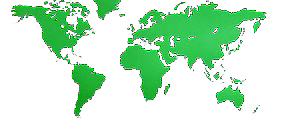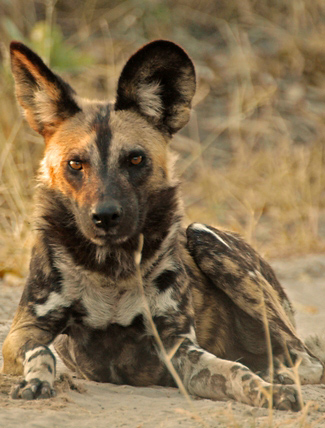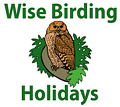

African Wild Dog in Botswana by Marie-France Grenouillet.
- A good chance of African Wild Dog
- And many other classic African mammals including Lion, Leopard, Cheetah, African Elephant, Giraffe, Hippopotamus and Spotted Hyaena, as well as Sable and Roan
- Some of Africa's and the world's most spectacular birds including Common Ostrich, flamingos, African Fish-eagle, Secretary Bird, Black and Goliath Herons, Saddle-billed Stork, Hamerkop and Kori Bustard
- And some of Africa's and the world's most spectacular localized birds including Wattled Crane, Pel's Fishing-owl, Slaty Egret and White-backed Night-heron
- All in a country where over a fifth of the terrain lies within unfenced 'protected' areas, a land which is sparsely populated by humans and densely populated by wildlife, and dominated by the Kalahari Desert and the Okavango Delta, the world's largest inland delta and one of the largest wetlands on Earth
- Wild Dogs are highly sociable and hunt in packs, chasing animals over considerable distances, communicating with each other on the run with strange yelps and combining so well as a team that nearly 80% of hunts end in a kill, a far better return than the 30% success rate of Lions! Their co-ordination is so good a pack at a kill can hold their own against scavenging Lions, as well as Hyaenas. Although they are long habituated to humans in vehicles, due to the distances they cover when hunting they are difficult to track down but during the denning season between July and September they tend not to travel so far and local rangers who know where their dens are can keep a close eye on their movements which means there is a much better chance of visitors seeing the ultimate hunters, especially in Khwai Concession, out of Kwara Camp in Moremi GR, and out of Selinda Camp in the Linyanti region of Chobe NP.
- Botswana has some of the most lavish and expensive lodges and safari camps in the world, some of which are accessible by light aircraft only, adding further to the expense of visiting them, but virtually all of the birds including the highly localized Slaty Egret, and some of the mammals, may be seen just across the border in much more reasonably priced Namibia.
- Some organized tours to Botswana include in their set itineraries, or offer as an optional extension, a trip to nearby Victoria Falls in Zambia, one of Our Top 50 Other Natural Wonders. There or nearby it is possible to see such birds as Black-cheeked Lovebird and Rock Pratincole.
Best Birds and other wildlife in Botswana
Birds
Near-endemics
Botswana, Angola and Namibia 1 Black-faced Babbler.
Botswana, Angola, Namibia and South Africa 5 Burchell’s Courser, Short-toed Rock-thrush, Karoo Chat, Tractrac Chat and Stark’s Lark.
Botswana, Namibia and South Africa 6 White-backed Mousebird, Fairy Flycatcher, Black-eared Sparrow-lark, Rufous-eared Warbler, Karoo Thrush and Sociable Weaver.
Botswana and South Africa 1 Short-clawed Lark.
Botswana, South Africa and Mozambique 2 Cape White-eye and Fiscal Flycatcher.
Botswana, South Africa, Mozambique and Zimbabwe 1 Cape (Orange-throated) Longclaw.
Other specialities
Slaty Egret, Wattled Crane, Pel's Fishing-owl, Racket-tailed Roller and Bradfield's Hornbill. Also a chance of Bronze-winged Courser.
Others
Common Ostrich, African Pygmy Goose, Lesser and Greater Flamingos, Great White and Pink-backed Pelicans, African
Darter, Black, Goliath and Rufous-bellied Herons, White-backed Night-heron, Hamerkop, Saddle-billed Stork,
vultures, African Fish-eagle, Bateleur, Martial, Steppe and Tawny Eagles, Secretary Bird, Black Crake, Kori
Bustard, Grey Crowned Crane, Spotted Thick-knee, Blacksmith and Chestnut-banded Plovers, White-headed Lapwing,
African and Lesser Jacanas, Temminck's Courser, Greater Painted-snipe, African Skimmer, Burchell's and Double-banded
Sandgrouse, Brown (Meyer's) Parrot, Coppery-tailed Coucal, owls including Verreaux's Eagle-owl, Red-faced Mousebird,
Narina Trogon, kingfishers including Giant, bee-eaters including Southern Carmine (nesting colonies usually
occupied Sep-Nov), Swallow-tailed and White-fronted, Lilac-breasted Roller, hornbills, Southern Ground-hornbill,
Retz's and White-crested Helmetshrikes, Grey-breasted and Sulphur-breasted Bushshrikes, Crimson-breasted Gonolek,
Magpie Shrike, African Paradise-flycatcher, Arnot's Chat, Groundscraper Thrush, starlings, Red-billed and
Yellow-billed Oxpeckers, sunbirds, Scaly-fronted Weaver and waxbills. Also a chance of African Finfoot.
Mammals
Lion (including black-maned ones in Central Kalahari GR), Leopard, Cheetah,
African Elephant, Giraffe, Hippopotamus, Spotted Hyaena, Burchell's Zebra, Blue Wildebeest, African Buffalo, Chacma
Baboon, Vervet Monkey, Bat-eared Fox, Spring Hare, Sable, Roan, Eland, Greater Kudu, Red Lechwe, Topi (Tsessebe),
(Red) Hartebeest, Impala and Springbok. Also a chance of African Wild Dog (especially Jul-Oct), Caracal, Brown
Hyaena, Aardwolf, Gemsbok, Sitatunga and Honey Badger.
Reptiles
Nile Crocodile.
Other Natural Wonders of Botswana
Okavango Delta A seasonal 15,000 sq km (5800 sq mile) world of water, waterbirds and mammals in the Kalahari Desert. It usually takes six months for the water, which originates in the Angolan highlands, to wash across the 250 km (155 miles) from the north to the south of the delta, which is also about 150 km (90 miles) across, and water levels usually reach a peak between June and August (in the dry season).
Kalahari Desert A 900,000 sq km (350,000 sq mile) region which covers much of Botswana. Most of the Kalahari is not true desert and receives sufficient rainfall to support enough vegetation to attract a wide variety of wildlife.
Best Sites for Birds and other wildlife in Botswana
- Okavango Delta Area
- Shakawe River Lodge Pel's Fishing-owl, Slaty Egret, White-backed Night-heron, African Pygmy Goose, African Skimmer, Coppery-tailed Coucal, African Wood-owl, Narina Trogon, Giant Kingfisher and Southern Carmine Bee-eater (colony).
- Stanley's Camp Pel's Fishing-owl, Slaty Egret, Wattled Crane and Red Lechwe.
- Khwai Concession Lion and night-drives for Leopard, Bat-eared Fox and Spring Hare, as well as Black and Rufous-bellied Herons, Lesser Jacana, and Temminck's Courser. Also a chance of African Wild Dog.
- Moremi GR Lion, Giraffe, Red Lechwe, Spotted Hyaena, Slaty Egret (Xakanaxa), African Pygmy Goose (Xakanaxa), Lesser Jacana and Wattled Crane (Xakanaxa). Also a good chance of African Wild Dog (especially at Kwara Camp), Leopard, Cheetah and Sitatunga.
- Chobe NP
- Linyanti region The arid region African Elephants migrate across as the wet season (Nov-Mar) approaches, to reach the Okavango Delta. Also a chance of African Wild Dog (especially at Selinda Camp).
- Savuti Area Lion (one pride hunts elephants), African Elephant (including large bulls), Giraffe, Spotted Hyaena, Sable, Roan, Common Ostrich, Swainson's Francolin, Secretary Bird, Kori Bustard, Burchell's Sandgrouse, Swallow-tailed Bee-eater, Southern Ground-hornbill, Bradfield's Hornbill, Crimson-breasted Gonolek and Magpie Shrike. Also a chance of Leopard, Cheetah and Honey Badger.
- Chobe River Nile Crocodile, Giraffe, Sable, Roan, Saddle-billed Stork, Kori Bustard, Slaty Egret, Black, Rufous-bellied and White-backed Night Herons, White-headed Lapwing, African Skimmer, Giant Kingfisher, White-fronted Bee-eater and Racket-tailed Roller. Also a chance of African Finfoot and Bronze-winged Courser.
- Makgadikgadi Salt Pans NP Meerkat, Burchell's Zebra, Blue Wildebeest (both on migration, Feb-Mar), Spring Hare, Springbok, Common Ostrich, Lesser and Greater Flamingos (nest in good years on Sua Pan, usually Dec-Apr), Wattled Crane, Kori Bustard, Slaty Egret, Great White Pelican (nest in good years, usually Dec-Apr), Chestnut-banded Plover, Temminck's Courser and Racket-tailed Roller. Also a chance of Caracal, Brown Hyaena, Aardwolf, Gemsbok and Sable.
- Off the main circuit
- Central Kalahari GR Lion (black-maned), Cheetah and Springbok (largest numbers usually in Jan when young are born). Also a chance of African Wild Dog.
- Kgalagadi Transfrontier Park (Kalahari Gemsbok Reserve) Lion, Leopard, Cheetah, Spotted Hyaena, Blue Wildebeest, Spring Hare, Gemsbok, Springbok, Ostrich, Kori Bustard, Swallow-tailed Bee-eater, Crimson-breasted Gonolek and Groundscraper Thrush. Also a chance of African Wild Dog, Meerkat, Brown Hyaena and Burchell's Courser.
Best Times for Birds and other wildlife in Botswana
The driest period of the year is usually May-June to October and May to August is the peak time to visit to look for mammals, because as the waters of the Okavango start to recede the animals begin to concentrate around the remaining water, making it easier to see them. July to September is usually the best time to look for African Wild Dogs because they usually den then, and September-October, which is almost as good for mammals, is one of the best times to be in Botswana because Southern Carmine Bee-eaters are usually busy at their nesting colonies at this time. When the rains come, usually in November, mammals and birds start to disperse, and the wet season usually lasts until March-April.
Recommended Bird Books etc. for Botswana
Bradt Travel Guides: Botswana Safari Guide by C McIntyre. Bradt, 2014 (Fourth Edition).
Travellers' Wildlife Guides: Southern Africa by B Branch et al. Interlink Books, 2013.
Bradt Travel Guide: Southern African Wildlife by M Unwin. Bradt, 2011 (Second Edition).
Watching Wildlife: Southern Africa by M D Firestone et al. Lonely Planet, 2009 (Second Edition).
Stuarts' Field Guide to Mammals of Southern Africa by C and M Stuart. Random House Struik, 2015 (Revised Edition).
The Kingdon Field Guide to African Mammals by J Kingdon. Bloomsbury, 2015 (Second Revised Edition).
The Kingdon Pocket Guide to African Mammals by J Kingdon. Bloomsbury, 2016 (Second Edition).
Birds of Botswana by P Hancock and I Weiersbye. PUP, 2015.
SASOL Birds of Southern Africa by I Sinclair et al. C Struik, 2020 (Fifth Edition).
Birds of Africa south of the Sahara by I Sinclair and P Ryan. C Struik, 2011 (Second Edition).
Newman's Birds by Colour by K Newman. C Struik, 2011 (Third Edition).
Newman's Birds of Southern Africa by K and V Newman. C Struik, 2010 (Tenth Edition).
Roberts Bird Guide edited by H Chittenden. Africa Geographic, 2007.
Southern African Birdfinder by C Cohen and C Spottiswoode. New Holland Publishers, 2005.
Apps etc.
eGuide to Mammals of Southern Africa
The Kingdon Guide to African Mammals.
Audubon African Wildlife.
SASOL eBirds of Southern Africa.
Newman's Birds of Southern Africa.
Roberts Multimedia Birds of Southern Africa.
Where to watch birds in Africa by N Wheatley. Helm, 1995.
Don’t know which country/countries to visit in Africa? Then it may be worth considering taking a look at this book, written by this website’s author. It is many years old of course but it still provides a starting point, an overview and a guiding light to the best birds and the best places to look for them on the continent, and could save hours of searching for similar information on the internet. However, it is important to check more up-to-date sources for sites which have been opened up, sites and species which have been discovered, lodges that have been built etc. since the book was published.
Birding and Wildlife Trip Reports for Botswana
Many trip reports, some for Botswana, are posted on the websites listed here. On some of these websites some reports are independent and some are posted by tour companies who organize tours to Botswana. These tour companies and others also post their own reports on their websites, which are listed under 'Some Organized Tours to Botswana' below.
- The best website for trip reports is CloudBirders
- but these are also worth a look
- Birdtours
- Fatbirder
- Jon Hornbuckle
- Mammal Watching
Local bird and wildlife guides in Botswana
The costs of organized tours partly reflect the quality of the tour leaders. Some leaders are certainly better than others and many companies claim their leaders are the best but even the best rely at least to some extent on the exceptional skills of the local guides they employ. If you are travelling independently, employing such local guides will greatly increase your chances of seeing the wildlife you wish to see.
Accommodation for birders in Botswana
Some Organized Tours for birds and other wildlife to Botswana
There are many tour companies who organize tours to see mammals, birds, other wildlife and other natural wonders. The cost of these tours vary considerably according to such variables as the airlines used, the number of days the tours last, the number of sites visited, the number of people in the group (an important consideration if you wish to see such wildlife as rainforest mammals and birds), the number of tour leaders, the standard of accommodation and transport, and the percentage profit the company hopes to make. Generally, where the number of days tours last and the number of sites visited are similar, the cheapest tours are those that use the cheapest airlines, accommodation and local transport, that have the largest groups with the least number of leaders, and that make the least amount of profit. The most expensive tours tend to be those which are exceptionally long, use the most expensive accommodation (ridiculously lavish in some cases, even for single nights) and which make the most profit. Some tour costs partly reflect the quality of the tour leaders. Some leaders are certainly better than others and many companies claim their leaders are the best but even the best rely at least to some extent on the exceptional skills of the local guides they employ.
While tour companies organize tours with set itineraries many also organize custom tours for individuals and private groups who instead of taking a tour with a set itinerary want to follow their own itinerary to suit their own personal tastes, whether it be mammals, birds, other wildlife, other natural wonders or even man-made attractions, or a mixture of them all. Many organized tours with set itineraries are also fast-paced and target as many species as possible, whether they are mammals, birds or other wildlife or everything, which usually leaves little time to enjoy the best sites and individual species, but on a custom tour those taking part can specify the pace and the sites and species they wish to concentrate on. Custom tours also suit people who like to travel with people they already know, rather than with a group of strangers, and people with partners with different interests. Individuals and small groups will almost certainly have to pay more than the price of an organized tour with a set itinerary but a large group of friends may be able to travel for less than the price quoted for a set tour.
Tour companies who run organized tours or can arrange custom tours to Botswana include the following.

